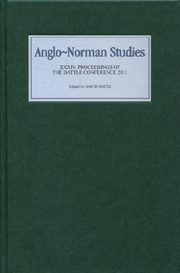Book contents
- Frontmatter
- Contents
- LIST OF ILLUSTRATIONS AND TABLES
- EDITOR'S PREFACE
- ABBREVIATIONS
- Mints and Money in Norman England
- Literate Sociability and Historical Writing in Later Twelfth-Century England
- The Archbishopric of Canterbury and the So-called Introduction of Knight-Service into England
- Lastingham and the Architecture of the Benedictine Revival in Northumbria
- ‘Lanfranc of Bec’ and Berengar of Tours
- The Invention of the Manor in Norman England
- Herbert Losinga's Trip to Rome and the Bishopric of Bury St Edmunds
- Le récit de Geoffroi Malaterra ou la légitimation de Roger, Grand Comte de Sicile
- The Two Deaths of William Longsword: Wace, William of Malmesbury, and the Norman Past
- The Beasts Who Talk on the Bayeux Embroidery: The Fables Revisited
- The Piety of Earl Godwine
Literate Sociability and Historical Writing in Later Twelfth-Century England
Published online by Cambridge University Press: 05 April 2013
- Frontmatter
- Contents
- LIST OF ILLUSTRATIONS AND TABLES
- EDITOR'S PREFACE
- ABBREVIATIONS
- Mints and Money in Norman England
- Literate Sociability and Historical Writing in Later Twelfth-Century England
- The Archbishopric of Canterbury and the So-called Introduction of Knight-Service into England
- Lastingham and the Architecture of the Benedictine Revival in Northumbria
- ‘Lanfranc of Bec’ and Berengar of Tours
- The Invention of the Manor in Norman England
- Herbert Losinga's Trip to Rome and the Bishopric of Bury St Edmunds
- Le récit de Geoffroi Malaterra ou la légitimation de Roger, Grand Comte de Sicile
- The Two Deaths of William Longsword: Wace, William of Malmesbury, and the Norman Past
- The Beasts Who Talk on the Bayeux Embroidery: The Fables Revisited
- The Piety of Earl Godwine
Summary
‘In order to remember the deeds and the words and the conduct of the ancestors’, recommends Wace in the prologue to his Roman de Rou, ‘people should read out books and histories and stories at festivals.’ ‘Many things that happened long ago’, he goes on to say, ‘would have been forgotten if documents [escripture] had not been written and then read and recounted by clerks.’ As a vernacular commendation of the pedagogical value of history and of the written word, Wace's comments are well known.3 However, his emphasis on the public staging of writing – on the use of written things at festes- has not been much discussed. This is curious because Wace's comments present such a rare and arresting articulation of the distinctive modalities of public remembrance in the High Middle Ages. For Wace, memory is embodied in the written word. But it is expressed by the voice, and it is staged and recalled in the public assembly. And while it is hardly new to note that books and stories were recited at festivals in this period, it is striking to see these bookish performances being invoked in such proximity to the recital of a more generic escripture.
This essay draws out the connections between the performance of literary and historiographical texts – Wace's livres, estoires et gestes- and other public uses of the written word in the late twelfth century. More specifically, it explores how the recitation of documents could act as a form of public, and authorized, storytelling in the lands either side of the English Channel in the High Middle Ages.
- Type
- Chapter
- Information
- Anglo-Norman Studies 34Proceedings of the Battle Conference 2011, pp. 23 - 40Publisher: Boydell & BrewerPrint publication year: 2012

